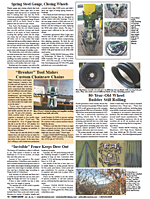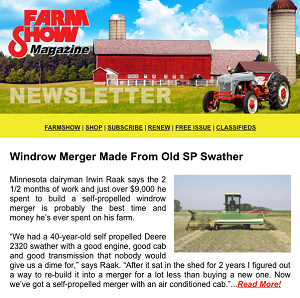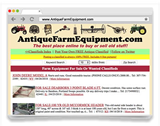Cheap Way To Build Your Own Greenhouse
When Lenny Smith, Lake Mills, Wis., quit farming and went into the greenhouse and "U-pick" vegetable business four years ago, he decided to keep costs down by putting up his own greenhouses. He built two of them out of old school buses.
They cost almost nothing and are cost efficient to operate," says Smith, who uses his "greenhouse buses" to grow potted flowers and hanging baskets.
Smith got the buses - minus the engines - for nothing from a local bus company. He sold the power steering units and rear ends and then removed the seats and cut off the roof. He left three supports across the top where the roof was riveted onto the bus and then put a double layer of clear polyethylene over the top. A small electric fan is used to blow air into the space between the two layers. Wooden benches on each side of the bus are used to hold plants, and a pair of steel rods running lengthwise at the top of the bus are used for hanging baskets.
A Taylor outside woodburning boiler is used to heat the bus. A pump circulates hot water underground through a 3/4-in. dia. pipe that enters the bottom of the bus. It's connected to a 2-in. dia. plastic finned pipe that runs under each bench. A plastic pipe at the front of the bus connects the two pipes. After the water circulates it exits through another underground pipe and into the other bus, then is piped back into the boiler.
These inexpensive greenhouses keep my growing costs to a bare minimum," says Smith. "Everything inside the bus was made mostly out of scrap material that I already had. I burn discarded pallet wood in the outside furnace, and I built the benches out of old wooden crates with 1 by 6 boards that I got from a local cornpany. The greenhouses stay warmer than our other greenhouses because of the glass windows. If it gets too hot inside the bus I can open the windows or the front or back door.
Each bus has about 200 sq. ft. to work in. We start growing plants in them around February 1st and use them until the end of June. We can get 75 flats and about 50 hanging baskets in each bus. I use a garden hose to water the plants.
The fan keeps the two layers of poly blown up so they stay nice and tight so the plastic won't be torn by the wind. To hook up the blower, I cut a hole in the plastic and used a screw lock ring to attach flexible tubing. When I cut off the roof I left some tin on each side of the supports and bent it down so that the sharp edges wouldn't tear the plastic. I mounted a series of nailed-together ,2 by 6 boards length-wise over the the supports to keep the plastic from hanging down over the aisle between the benches.
The plastic is sandwiched between two boards that I fastened to the outside of the bus. I screwed one board on outside the bus, then inserted the plastic and nailed the other board on."
Contact: FARM SHOW Followup, Lenny Smith, N4716 Hwy. G, Lake Mills, Wis. 53551 (ph 414 674-2281).

Click here to download page story appeared in.
Click here to read entire issue
Cheap Way To Build Your Own Greenhouse FARM HOME Miscellaneous 19-2-34 When Lenny Smith, Lake Mills, Wis., quit farming and went into the greenhouse and "U-pick" vegetable business four years ago, he decided to keep costs down by putting up his own greenhouses. He built two of them out of old school buses.
They cost almost nothing and are cost efficient to operate," says Smith, who uses his "greenhouse buses" to grow potted flowers and hanging baskets.
Smith got the buses - minus the engines - for nothing from a local bus company. He sold the power steering units and rear ends and then removed the seats and cut off the roof. He left three supports across the top where the roof was riveted onto the bus and then put a double layer of clear polyethylene over the top. A small electric fan is used to blow air into the space between the two layers. Wooden benches on each side of the bus are used to hold plants, and a pair of steel rods running lengthwise at the top of the bus are used for hanging baskets.
A Taylor outside woodburning boiler is used to heat the bus. A pump circulates hot water underground through a 3/4-in. dia. pipe that enters the bottom of the bus. It's connected to a 2-in. dia. plastic finned pipe that runs under each bench. A plastic pipe at the front of the bus connects the two pipes. After the water circulates it exits through another underground pipe and into the other bus, then is piped back into the boiler.
These inexpensive greenhouses keep my growing costs to a bare minimum," says Smith. "Everything inside the bus was made mostly out of scrap material that I already had. I burn discarded pallet wood in the outside furnace, and I built the benches out of old wooden crates with 1 by 6 boards that I got from a local cornpany. The greenhouses stay warmer than our other greenhouses because of the glass windows. If it gets too hot inside the bus I can open the windows or the front or back door.
Each bus has about 200 sq. ft. to work in. We start growing plants in them around February 1st and use them until the end of June. We can get 75 flats and about 50 hanging baskets in each bus. I use a garden hose to water the plants.
The fan keeps the two layers of poly blown up so they stay nice and tight so the plastic won't be torn by the wind. To hook up the blower, I cut a hole in the plastic and used a screw lock ring to attach flexible tubing. When I cut off the roof I left some tin on each side of the supports and bent it down so that the sharp edges wouldn't tear the plastic. I mounted a series of nailed-together ,2 by 6 boards length-wise over the the supports to keep the plastic from hanging down over the aisle between the benches.
The plastic is sandwiched between two boards that I fastened to the outside of the bus. I screwed one board on outside the bus, then inserted the plastic and nailed the other board on."
Contact: FARM SHOW Followup, Lenny Smith, N4716 Hwy. G, Lake Mills, Wis. 53551 (ph 414 674-2281).
To read the rest of this story, download this issue below or click
here to register with your account number.








